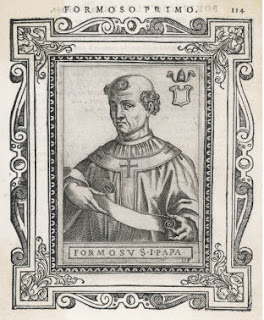Throughout history there have always been extremely strange
rituals that seem to defy understanding. The Cadaver Synod was one of
these.It involved the macabre process known as
posthumous execution. This is the process of exhuming a corpse and
conducting a ritual or ceremonial mutilation of the remains. The only
case of a Cadaver Synod was enacted upon Pope Formosus, 816-896.
(picture 1), one year after his death. The trial was
conducted by Formosus’ second successor, Pope Stephen VI. Stephen VI
accused Formosus of perjury and acceding to the papacy illegally.
Formosus’ corpse was disinterred, clad in papal
vestments, and seated on a throne (picture 2). In the ruling, it was
declared that Formosus was unworthy of the pontificate, and all acts and
measures made under his papacy were declared null and void. This
included the removal of three of his fingers, as they had been used in
various “illegitimate” consecrations. So loathsome was Formosus’ body
deemed, that clerics had it thrust into the Tiber River. It was quickly
retrieved by a monk and kept in an unmarked burial plot.
Following the death of Stephen VI, Formosus’ body was
re-interred in St. Peter’s Basilica. Further trials of this nature
against deceased persons were banned, but Pope Sergius III (904–911)
re-approved the decisions against Formosus. His body was once again
exhumed and a second Cadaver Synod was performed. This time, Formosus’
punishment was a beheading and his remains were once again thrown into
the Tiber River where they remained.
The Cadaver Synod is remembered as one of the most bizarre episodes in the history of the medieval papacy.


No comments:
Post a Comment